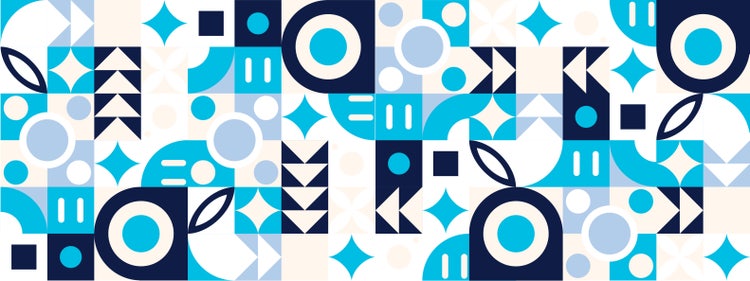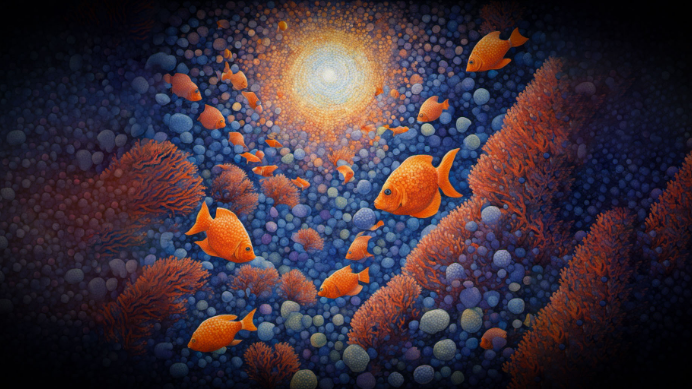Adobe Spotlight: The power of conversation during National Disability Employment Awareness Month 2023

Image credit: Adobe Stock/ Roisa.
Every October, Adobe recognizes National Disability Employment Awareness Month (NDEAM) to commemorate the contributions of people with disabilities (PwD) to the workplace and our economy. In acknowledgment this year, our Access at Adobe Employee Network is centering employee engagement activities around the internal NDEAM theme “Unseen journeys, open conversations.” This theme honors the stories and experiences of individuals with both visible and invisible disabilities who have found their sense of belonging in the workplace. Additionally, it underscores the significance of ensuring that PwD have equitable opportunities to prepare for and excel, fostering a diverse, equitable, and inclusive workforce also enhances innovation and creativity.

Artwork by Michelle Callahan and Priyank Modi.
This image honors our theme and was designed by Michelle Callahan, technical consultant, operations at Adobe, and Priyank Modi, software development engineer at Adobe. As described by the designers, “The coral is orange, and some fish are hiding behind it. Their journey toward the sun is unseen by some, but the ones in front are finally being seen. The water is calming and freeing. There is a sense of community since everyone is coming together, moving toward the same goal — the bright sunlight.”
Removing barriers for PwD is core to our vision of Adobe for All in our workplace and the communities in which we operate. We strive to create an environment where people can do their best work and drive their career growth based on personal goals.
During our recent Adobe for All Days, we reaffirmed our long-term commitment to accessibility by launching our new accessibility principles: Partnership, Transparency, and Innovation. During the weeklong, company-wide event, we hosted three panelists who shared their experiences and creative journeys. We’re proud to reaffirm our commitment to accessible and equitable business practices while continuing to acknowledge the impact PwD have.
Adobe for All Days session recap: New Accessibility Principles to foster inclusive practices
During Adobe for All Days, we hosted a panel discussion focused on the importance of advancing digital inclusion. The session included three panelists: Tom Babb, Manish Agrawal, and Jen White-Johnson who shared what imagination means to them, their creative process, features, and tech they use most often, what barriers they face and opportunities ahead. Here are a few highlights from the panel:
Tom Babb is an inspiring individual who has defied challenges and found his artistic passion through Adobe software. He was in a wave accident at 19, leaving him paralyzed from the shoulders down. He had to relearn how to navigate the computer without the use of his hands, using his head movements for the mouse and speech-to-text to type. In 2020, Tom taught himself Adobe Illustrator, Adobe Photoshop, and Adobe Premiere Pro. The software has given him a new purpose and opened a world of possibilities. Now, he creates content for a startup called SkyFi in Austin.
Q: Tom, can you tell us about your decision point and how you pivoted the ways you express yourself after your accident?
Babb: Sure, I am paralyzed from the shoulders down, so I don't have function over my hands, this happened when I was 19, a freshman in college. I decided that I needed a creative outlet, I was feeling very trapped with a bunch of emotions, feelings, and ideas. I wanted to get everything out on paper, but I can't do that anymore because my hands didn’t function. So, I decided that I needed a tool to help me with that. I started with limited tools, and I was still feeling confined within that, I wasn't able unleash my ideas and I and I needed a tool that would essentially allow me to do whatever I wanted to do. A few of my professors showed me Adobe Illustrator so that’s where I started. From there I realized what I could do, I was extremely excited. I probably spent 10 to 15 hours a week, playing around and making my ideas come to life. Fast forward, three or four years and I am in a position where I can make whatever I want, and my coworkers will turn to me to bring their ideas to life as well.
Manish Agrawal is the founder of IAccessible, a disability-owned social enterprise built on the premise of “nothing for us without us!” His organization channels the skills and experience of PWD to bridge the Disability Divide. Manish has been blind for over 20 years and has been driving accessibility innovations at Microsoft and other companies for years.
Q: Manish, what do you think is the biggest barrier or opportunity to creating equitable and inclusive software?
Agrawal: In my opinion the biggest barrier and really the biggest opportunity that we have as product makers to build more equitable, inclusive software, is making PwD be a part of the product building process. The best way to do this is to hire more PwD on our teams. It's no different than hiring people who have domain expertise for the products that you're building for a specific domain, right? PwD are the experts in accessibility because they live it every day. If hiring isn’t possible now or isn't enough, you can work with companies like, IAccessible, who hire PwD and train them on inclusive design and accessibility testing, everyone on our team has lived experience with disabilities and the inputs they bring are unmatched.
The other suggestion I have is to build robust feedback mechanisms into your software to capture usability and accessibility inputs from real users with disabilities, then channel that feedback back to engineering and design teams. These can accelerate our mission to build more equitable software. Read more about Manish’s story here: IAccessible gives all technology users a seat at the table.
Jen White-Johnson, an Afro-Latina designer from Baltimore, Maryland. She passionately advocates for disability design justice. Her journey with Adobe tools has been intertwined with her identity as a neurodivergent individual with ADHD and an autoimmune disorder. Through creativity and resilience, Jen exemplifies how creativity can open doors to new possibilities, even in the face of adversity.
Q: Jen, can you tell us more about what you mean by mothering as an act of resistance? What are you looking forward to with regards to innovation?
White-Johnson: My definition of mothering as an act of resistance aims to activate change — encouraging families and communities to engage in conversations about acceptance and joy, starting with how neurodivergent children and adults are treated, valued, and seen. Black disabled women and girls experience economic insecurity at higher rates, often due to job loss — sub-minimum wages — as low as $2.13 per hour — for disabled workers — and reduced earnings caused by access barriers to equitable education and skills development. We are often stigmatized and viewed as not being able to keep up when in fact we have our own unique strategies of making and creating tailored to our needs!
For innovation, to echo what Manish said, make sure you are representing specific communities, not only in process but in content and output as well. Especially having the neurodivergent voice to lean on their disability wisdom when it comes to being responsible and ethical. For instance, we need to make sure text prompts are encouraging the community and image results are not a reflection of the misrepresentation and stigmas typically rooted in disability — what would it look like if these innovations were specifically like curated? We could think about a text prompt workshop led specifically by disabled and neurodivergent folks to help shift the stigma when it comes to imagery and what we’re looking to represent us. I’m looking forward to more leadership being put into place when it comes to those types of elements. Read more about Jen’s story here: For Jennifer White-Johnson, AI is a platform for activism
Five ways to increase inclusion
We recognize building a more inclusive work environment is a collective effort that involves everyone in the organization. According to The Return on Disability Report the disability market continues to grow with an estimated 1.85 billion people globally. Consumer insights experts also monitor and include the friends and family of PwD, adding another 3.4 billion potential consumers. We are committed to removing barriers faced by PwD to make transformative change.
By taking action, and initiating conversation, people from across the organization can contribute to a more diverse, equitable, and inclusive workplace culture. This leads to better collaboration and helps drive even more inclusion and innovation within our products and their features. Here are five tips to help guide teams when integrating more inclusion in their work:
- Partner with the community for feedback. Hire PwD for your team. Work directly with PwD on your projects. Adobe joined the ProcureAccess initiative by Disability:IN, bringing together companies that recognize the importance of buying and selling technology that is accessible to PwD.
- Master the basics. Learn how to identify and remove potential barriers. For example, Adobe has developed an internal Digital Accessibility Guide, offering a wealth of information for product teams on how to effectively address accessibility.
- Embrace diversity in creativity. Everyone can imagine, and everyone can create. Make sure your products and tools available for employees are accessible. In order to help achieve that, we created an internal Accessibility Support Desk for PwD. This will encourage feedback from employees with disabilities with the dedicated support desk helping to remove barriers for accessibility issues they may encounter with third-party tools. By doing so, we can take prompt action to address these concerns and ensure a more inclusive and supportive workplace.
- Advocate for the user. Find ways to prioritize accessibility in your work. We recently launched our internal Blueline annotation training to add notes and design specs with rich descriptions to illuminate the aspects of the user interface exposed to assistive technologies, keyboard and keyboard equivalents that benefit users of all abilities.
- Dream big. Explore innovative ways to solve accessibility problems and amplify creativity.
Inclusive innovation benefits everyone, not just PwD. By building more accessible products and features, we are creating a better user experience, while contributing to a more diverse and representative digital landscape.
Throughout the rest of this month, we look forward to celebrating the uniqueness and brilliance of this community and will continue to cultivate a culture of diversity and inclusion year-round that fosters a sense of belonging while elevating diverse, underrepresented voices.